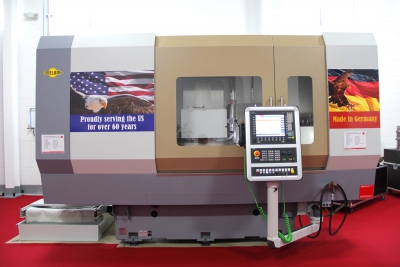
The smartLine variant is a flexible, modular machine concept. “The secret of our smartLine range is its modular structure,” points out Dr. Markus Stanik, managing director of Elb-Schliff. “We leverage a modular machine kit for the customized assembly of both surface grinding and complex profile grinding machines.”
The two-part machine base is made of mineral casting and is bonded together in the final production process. The existing front and back parts can be freely combined with one another, thus providing three different grinding widths and four different grinding lengths. The mineral casting used ensures the machine base of superior vibration damping in combination with high thermal stability. Machine damping is especially important when it comes to
grinding, which is why mineral casting has emerged as the optimal material for the machine bases of grinding machines used in production applications. As these grinding machines are used in a wide variety of industries, manufacturer Elb-Schliff supplies various axis drive and guide way options.
“Our decades of experience haves shown that this variety is important for many customers with quite different requirements, and reflects the difference between normal and top-quality products, both for the machine and the tool that is manufactured on it,” explains Dr. Stanik. This allows users to choose from linear guides and flat guides, ballscrews, toothed belts and hydraulic drives, always according to the grinding task.
Increased grinding performance and higher coolant pressure result in stronger coolant mist. Therefore, most machines are now completely enclosed to comply with the latest safety and environmental regulations and facilitate optimal ease of use for the machine operator. Modern machines with a full enclosure and mist extraction systems protect the machine operator’s health and ensure cleanliness in production – a basic requirement for high-precision manufacturing.
In addition, you can also choose from a wide range of grinding spindles with a wide variety of performance levels and dressing devices. These range from a fixed single point diamond to an overhead dresser through to multi-axis table dresser, all of which are available for this machine concept.
Related Glossary Terms
- coolant
coolant
Fluid that reduces temperature buildup at the tool/workpiece interface during machining. Normally takes the form of a liquid such as soluble or chemical mixtures (semisynthetic, synthetic) but can be pressurized air or other gas. Because of water’s ability to absorb great quantities of heat, it is widely used as a coolant and vehicle for various cutting compounds, with the water-to-compound ratio varying with the machining task. See cutting fluid; semisynthetic cutting fluid; soluble-oil cutting fluid; synthetic cutting fluid.
- dressing
dressing
Removal of undesirable materials from “loaded” grinding wheels using a single- or multi-point diamond or other tool. The process also exposes unused, sharp abrasive points. See loading; truing.
- flat ( screw flat)
flat ( screw flat)
Flat surface machined into the shank of a cutting tool for enhanced holding of the tool.
- grinding
grinding
Machining operation in which material is removed from the workpiece by a powered abrasive wheel, stone, belt, paste, sheet, compound, slurry, etc. Takes various forms: surface grinding (creates flat and/or squared surfaces); cylindrical grinding (for external cylindrical and tapered shapes, fillets, undercuts, etc.); centerless grinding; chamfering; thread and form grinding; tool and cutter grinding; offhand grinding; lapping and polishing (grinding with extremely fine grits to create ultrasmooth surfaces); honing; and disc grinding.
- surface grinding
surface grinding
Machining of a flat, angled or contoured surface by passing a workpiece beneath a grinding wheel in a plane parallel to the grinding wheel spindle. See grinding.








